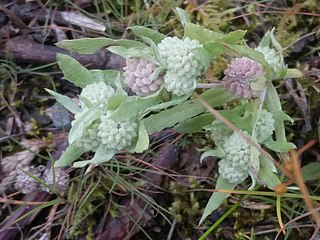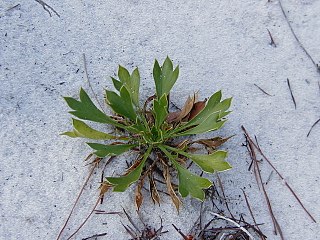Description
This is a hairy, somewhat fleshy, perennial herb growing branching stems to 20 or 30 centimeters in height. Dark green, narrowly spade-shaped leaves grow on long petioles and may grow erect with the stems or lie flat along the ground. They may have smooth to toothed to sharply serrated edges.
Flower heads are less than a centimeter wide with a few longer, straight, sharp bracts around the base. The tiny flowers packed into the rounded head are generally white. This plant is threatened by destruction of its fragile vernal pool habitat by a number of causes, including sediment-rich runoff into the pools from logging activity, erosion, development, and off-road vehicles.

Eryngium is a genus of flowering plants in the family Apiaceae. There are about 250 species. The genus has a cosmopolitan distribution, with the center of diversity in South America. Common names include eryngo and sea holly.

Eryngium aristulatum, known by the common names California eryngo and Jepson's button celery, is a species of flowering plant in the family Apiaceae.

Eryngium armatum, known by the common names coastal eryngo and prickly coyote thistle, is a species of flowering plant in the family Apiaceae.
Eryngium castrense is a species of flowering plant in the family Apiaceae known by the common name Great Valley eryngo, or Great Valley button celery. This plant is endemic to California, where it grows in wet areas such as vernal pools and ponds in the central part of the state. This is a heavily branched, spiny perennial herb reaching maximum heights of around half a meter. It produces light green to grayish green hairless stems with occasional lobed, oval-shaped leaves. At the tops of the stems are flower heads one to one and a half centimeters wide and rounded or egg-shaped. At the base of each head is an array of 7 to 9 spiny, pointed bracts up to three centimeters long, and sometimes a few smaller bractlets above. The rounded flower head contains many small white to light purple flowers.

Gratiola heterosepala is a species of flowering plant known by the common name Boggs Lake hedgehyssop.

The Loch Lomond Vernal Pool Ecological Reserve is a nature reserve of 8.22 acres (33,300 m2) in the community of Loch Lomond in Lake County, California. It is one of 119 ecological reserves managed by the California Department of Fish and Game (CDFG). The ecological reserve system was authorized by the state legislature in 1968 for the purpose of conservation and protection of rare plants, animals and habitats.
Lasthenia glaberrima is a species of flowering plant in the family Asteraceae known by the common names smooth goldfields and rayless goldfields. It is native to western North America from British Columbia to California, where it grows in wet meadows and vernal pools.
Lepidium oxycarpum is a species of flowering plant in the mustard family known by the common names forked pepperweed and sharp-fruited pepperweed.
Eryngium mathiasiae is a species of flowering plant in the family Apiaceae known by the common name Mathias' eryngo, or Mathias' button celery.
Eryngium pinnatisectum is an uncommon species of flowering plant in the family Apiaceae, known by the common names Tuolumne eryngo and Tuolumne button celery.
Eryngium racemosum is a rare species of flowering plant in the family Apiaceae known by the common name delta eryngo, or delta button celery.
Eryngium spinosepalum, known by the common names spinysepal eryngo and spiny-sepaled button celery, is an uncommon species of flowering plant in the family Apiaceae.
Eryngium vaseyi is a species of flowering plant in the family Apiaceae known by the common name coyotethistle. It is endemic to California, where it is known from vernal pools and similar wet habitat in the Central Valley and certain areas of the Central Coast Ranges and southern California coast. This is a decumbent to upright perennial herb with spreading branches up to half a meter long. The lance-shaped to oblong leaves may be up to 24 centimeters long. The edges are deeply cut into narrow, sharp-pointed lobes. The inflorescence is an array of somewhat rounded flower heads surrounded by several narrow, pointed bracts with spiny edges. The head blooms in whitish petals.

Psilocarphus brevissimus is a species of flowering plant in the family Asteraceae known by the common names short woollyheads, woolly marbles, and woolly heads.

Psilocarphus elatior is a species of flowering plant in the family Asteraceae known by the common names tall woollyheads, meadow woollyheads and tall woolly-marbles. It is native to the Pacific Northwest in western North America from Vancouver Island, where it is known from just a few occurrences, to northern California. It grows in seasonally moist spots such as meadows, spring seeps, and vernal pools.
Psilocarphus oregonus is a species of flowering plant in the family Asteraceae known by the common names Oregon woollyheads and Oregon woolly marbles. It is native to western North America from Washington and Idaho to Baja California, where it grows in seasonally wet habitat, such as vernal pools.

Eryngium pendletonense is a rare species of flowering plant in the carrot family known by the common name Pendleton button-celery. It is endemic to northern San Diego County, California, where it is known from four occurrences along the coastline between Oceanside and the Orange County border, including land within Camp Pendleton. It grows on vernally moist coastal grassland and coastal sage scrub habitat with clay soils. It was first described as a species in 1999.

Eryngium cuneifolium is a rare species of flowering plant in the carrot family known by the common names wedgeleaf eryngo, wedge-leaved button-snakeroot, and simply snakeroot. It is endemic to the state of Florida in the United States where it is known only from Highlands County. It is one of many rare species that can be found only on the Lake Wales Ridge, an area of high endemism. It was federally listed as an endangered species of the United States in 1987.

Eryngium aquaticum is a species of flowering plant in the family Apiaceae known by the common name rattlesnakemaster, marsh rattlesnake master, corn-snakeroot, bitter snakeroot, and marsh eryngo. This plant is native to eastern North America.
Eryngium baldwinii is a biennial aromatic herb in the Eryngium genus. Its common name is Baldwin's eryngo. It can grow to become a spread out groundcover with hazy appearing light blue flowers. It is named for Willliam Baldwin.










